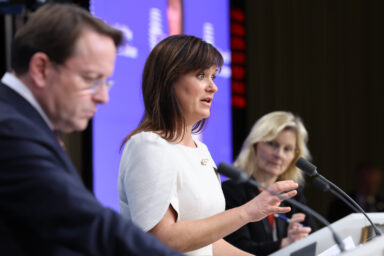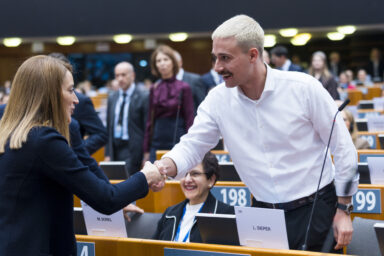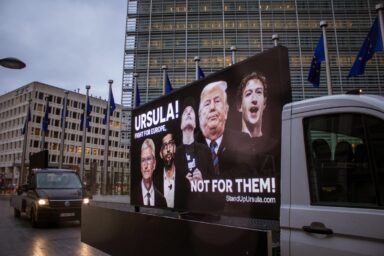Europe’s defence spending has entered a period of urgent recalibration. Decades of underinvestment have left the continent’s military-industrial base fragmented and under-resourced, a legacy now colliding with the geopolitical realities exposed by Russia’s invasion of Ukraine. How to fix it was what Juan Mejino-López, researcher at the Bruegel think-tank, debated with MEP Jan Farský and Burkard Schmitt, a defence industry representative, in the latest episode of the EU Perspectives podcast on 14 May.
To understand today’s European defence predicament, one must understand the past. “We are coming from a situation where we had defence spending around 3 per cent in Europe in the 80s,” noted Spanish economist Juan Mejino-López, research analyst with the Bruegel think-tank. “This has constantly decreased till now; and the production capacities have, of course, decreased as well.” The challenge lies not only in reversing this decline but also in ensuring that new spending—rising but still unevenly distributed—is coordinated effectively.
The scale of the problem is stark. European defence budgets fell steadily for thirty years, with equipment spending hit particularly hard. This atrophy left industries ill-prepared for sudden demand surges. Building production capacity for complex systems, Mr Mejino-López observed, “can take decades”, a timeline at odds with immediate security needs. The war in Ukraine has exposed critical shortcomings, from ammunition shortages to incompatible equipment standards. “The war has shown that we were not enforcing (our own) standards,” he warns.
Size matters
Coordination remains the linchpin. While national governments control defence procurement, fragmented spending perpetuates inefficiencies. The United States’ industrial dominance underscores this disparity: “The main three companies in the US have the same amount of revenues as the top 27 European companies for 2024.” This gulf widens as American firms secure global contracts, achieving economies of scale that European rivals cannot match.
Duplication exacerbates the issue. “If we are investing in three different types of combat aircraft,” Mr Mejino-López remarked, “we are putting resources towards three different research and development projects”, a costly approach compared to shared programmes.
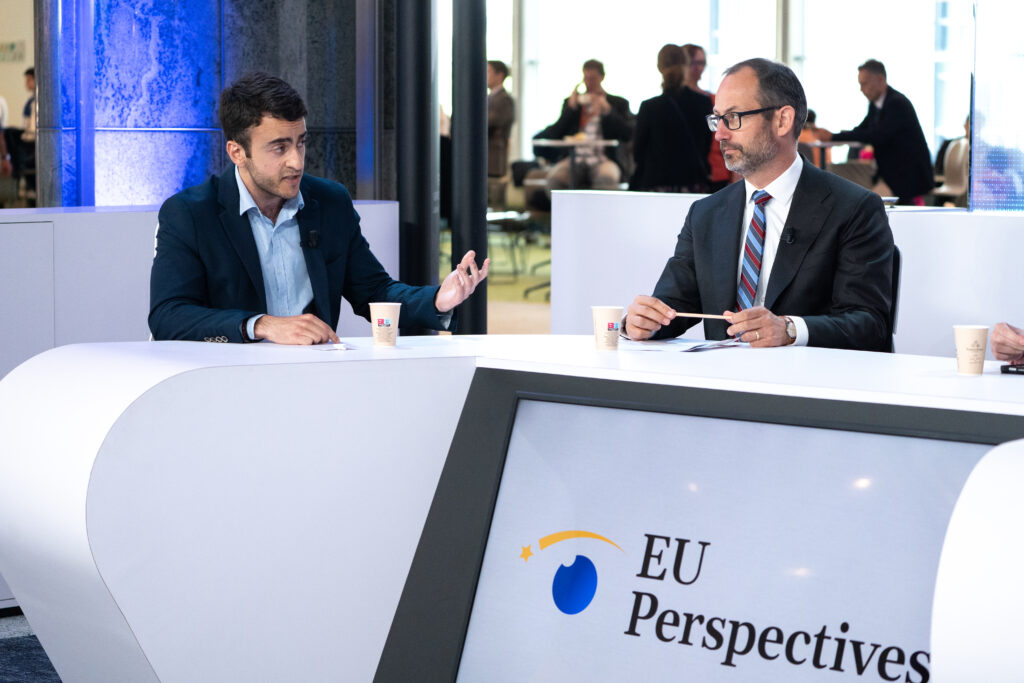
Efforts to pool procurement face political hurdles. Trust deficits among member states linger, shaped by differing threat perceptions. “The closer you are to Moscow, the more you spend on defence,” Mr Mejino-López noted, highlighting divergent strategic priorities. Eastern states, more exposed to a possible Russian aggression, have prioritised rapid acquisitions—often from non-European suppliers.
Lost opportunities
“We spent almost 80 per cent of defence spending outside of Europe, and 63 per cent in the United States,“ his fellow debater, MEP Jan Farský (EPP/CZE) agreed. According to Mr Mejino-López, niche dependencies persist mainly in areas like air defence. Poland, for instance, relies heavily on American and South Korean imports. By contrast, France and Germany predominantly source equipment domestically, he said.
The risk lies not in current imports but in lost opportunities for industrial growth, the Spanish economist said. American firms’ production delays, visible in combat aircraft backlogs, suggest that transatlantic partnerships alone cannot guarantee security.
You might be interested
The resulting patchwork undermines interoperability and weakens collective deterrence. Without deeper integration, Mr Mejino-López cautions, Europe risks being “underprepared” for future conflicts, possibly on NATO or EU territory. In defence matters, the price of disunity is too high.

Demand creates supply
Financial pressures compound the challenge. Joint procurement could lower costs through bulk purchasing and standardised systems. Yet national governments remain wary of ceding control over defence contracts. “The downside of buying European is higher prices,” Mr Mejino-López acknowledges, citing examples like main battle tanks and self-propelled howitzers.
However, emerging technologies suggest a path forward. Ukraine’s rapid drone production, the Bruegel scholar noted, demonstrates how “the cost is decreasing by a lot” when innovation aligns with scalable manufacturing.
Still, Europe lags in critical sectors. Venture capital flows into American defence startups working on AI and drones at double the speed when compared to their European counterparts.
Demand-side solutions are gaining traction. The European Commission has emphasised that “demand will create supply”, a view Mr Mejino-López endorses. Public spending commitments, he argues, must provide clear signals to the defence industry to justify long-term investments. The European Investment Bank (EIB) is easing financing barriers for small firms, while relaxed ESG criteria reflect shifting attitudes toward defence’s “stigma”.
Tanks are no airlines
However, major companies still grapple with fragmented national markets. “The issue is how we tackle the demand. We need to set clear incentives for national countries to spend together and spend better,” he insists.
Trust-building emerges as the overriding priority. Without it, joint procurement and standardisation will founder. “You want to know that you can trust the other member states to actually produce military equipment that you might need,” Mr Mejino-López stressed.

Historical integration successes, such as consolidated civilian aerospace sectors, offer limited reassurance. “Of course, we have seen in the past positive experience in terms of integrating the market, even as some countries lost their national airlines. But for defence companies, it’s a bit more complicated,“ Mr Mejino-López mentioned the defence industry‘s strategic sensitivity. However, recent progress, including EU funds for joint purchases and proposals for a defence industrial strategy, marks a tentative step toward more cohesion.
Learning from covid-19
The financing debate remains largely unresolved. While public funding dominates, private capital’s role is expanding. Mr Mejino-López downplays supply-side constraints: “The problem now is how we can create this demand,” he addressed one of the debate’s central questions.
He advocates for EU-level mechanisms to incentivise collaborative spending, mirroring the bloc’s pandemic-era vaccine procurement. Such approaches could mitigate redundancies while signalling market stability to investors. “If we don’t see any perception of threat, the demand will disappear,” he warns, underscoring the need for sustained political will.
Another participant in the podcast, Burkard Schmitt, Defence and Security Director of ASD Europe, went even further. “I think it would be important (for the EU) to have an important budget line for defence in the next Multiannual Financial Framework. I mean, we see that member states spent a lot, but if the EU wants to make a difference and have the means to push for greater cooperation, you have to have something in your own budget as well. As long as the EU sticks to the current level, it will not make a difference in favour of more cooperation. You have to be able to support your programmes and defence instruments with the necessary (budget) envelopes. Otherwise it will not make a difference at all,“ the German defence expert said.
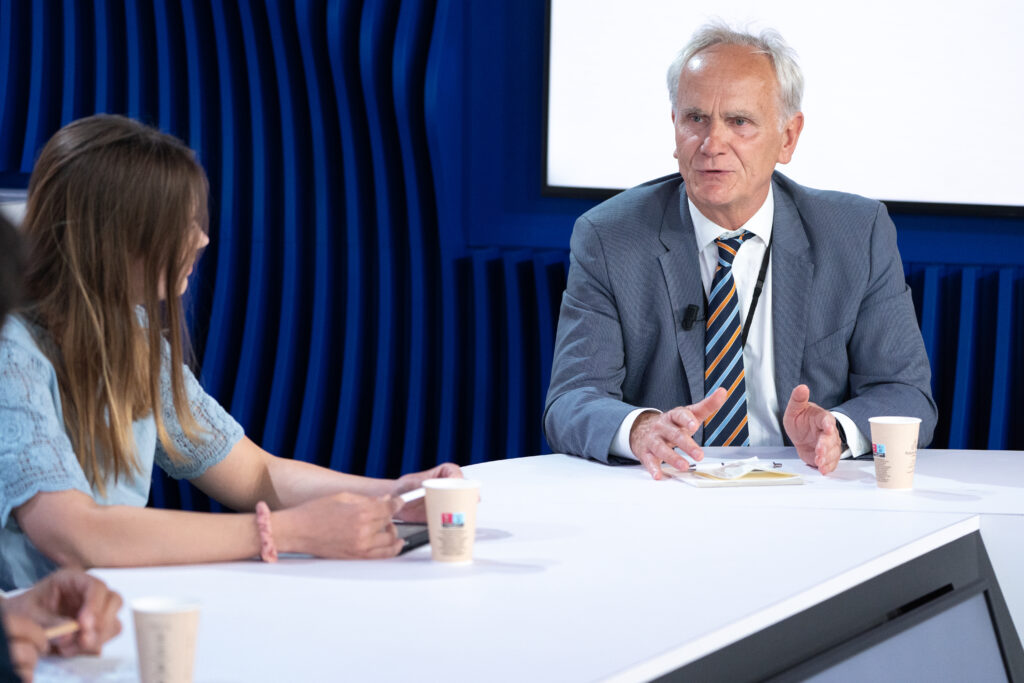
Sovereignty v integration
The path forward hinges on reconciling sovereignty with integration. Mr Mejino-López’s prescription is unambiguous: “The key target should be to carry the joint procurement, and eventually improve the single market.” This requires depoliticising defence industrial policy while respecting national sensitivities. Proposals to expand the European Defence Agency’s remit or create NATO-style procurement frameworks face scepticism but may gain more traction as threats mount.
Europe’s defence dilemma mirrors broader EU challenges: balancing collective action with national prerogatives. Without coordination, higher spending risks perpetuating inefficiencies. With it, the continent could harness its economic heft—but only if governments transcend zero-sum thinking. As Mr Mejino-López concludes, the alternative is stark: continued fragmentation leaves Europe “underprepared” in an era of renewed great-power rivalry. The coming years will test whether urgency can finally forge unity.



